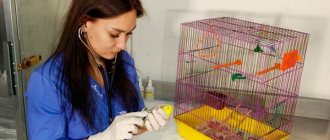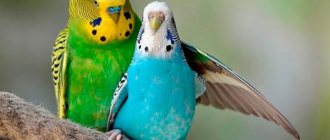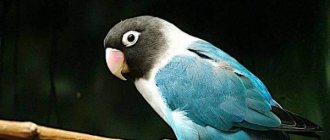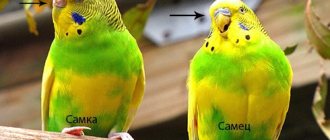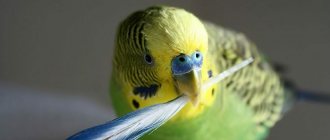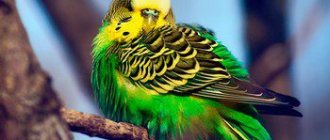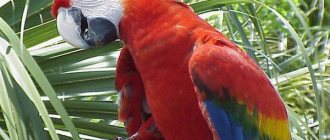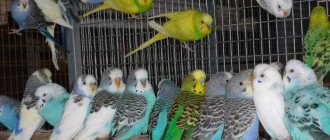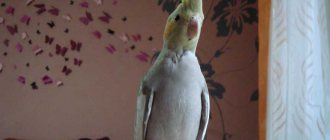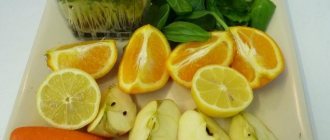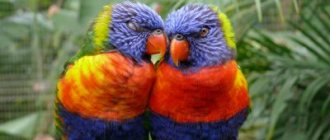Do you need to know how a pet is made from the inside? Some people believe that such details are unnecessary, but in practice it becomes clear that an orientation in the anatomy of a budgerigar will allow you to provide timely assistance to the feathered baby.
The respiratory organs of birds have a special structure. If you look behind the tongue, you can see the gap that leads into the larynx and trachea. The larynx is divided into the lower, with three pairs of muscles responsible for the voice, and the upper. Small pulmonary bladders are located in the chest; they contain bronchi and bronchioles. Air sacs are located between some organs and muscles. A budgerigar takes about 60-85 breaths per minute. Air sacs help to significantly increase the volume of inhaled air, thereby actively enriching the bird’s entire body with oxygen.
On either side of the nasal opening are the sinuses. They stretch around the eyeball, extend to the forehead, cover the neck area and reach the jaw bones. This is why colds are undesirable for pet parrots. You should avoid drafts and keep the cage away from open windows.
The digestive system is quite complex, like that of any living organism. Initially, the food ends up in the beak, where it is crushed and ground. Next, it moves along the esophagus and enters the goiter. There the food becomes softer due to the abundant secretion of saliva. The walls of the crop produce contractile movements, pushing what is eaten into the stomach (glandular), where they actively mix with stomach juice and end up in the muscular stomach, where digestion occurs. Beneficial components are absorbed into the blood and distributed throughout the budgie’s body, and harmful trace elements are sent to the liver.
Digestion of food occurs as intensively as possible, since the length of the esophagus is short. After the stomach, food debris enters the duodenum and small intestine. A fast metabolism makes parrots want to eat and drink all the time. Therefore, it is important that there is food for the parrots in the cage at all times, and only fresh, not cold water in the drinking bowl. The small intestine gradually turns into the rectum, ending in the cloaca. There, droppings mix with urine, which is why parrots defecate so often.
External structure
The budgerigar is considered a small representative of its family. The size of a mature bird varies around 18 cm (length is measured from the crown to the tip of the tail). You can also find “giants” - these are Czech budgerigars, the size of which reaches 24-28 cm. They were bred by breeders as an exhibition species.
Head
Looking at the proportions of the bird, the head looks large. It is flat on top, but rounded closer to the neck. The head is connected to the body through a movable joint, which in turn goes into the spine. The neck is extremely mobile and can rotate 180 degrees.
The animal's beak is rounded and quite powerful. With its help, the parrot cleans its feathers and obtains food for itself by breaking nuts and other solid food. The upper part of the beak is noticeably larger than the lower part and is not a continuation of the skull.
The bird's eyes distinguish all the colors of the rainbow, and its specific landing increases the viewing angle. Soft tissues are protected from external irritants by a thick membrane. Birds blink much less often than cats or dogs.
Budgerigars have monocular vision. That is, the animal's eyes are independent and can move separately. In this case, the bird sees two different images.
The pet's ears are hidden under feathers. Parrots use sound to navigate in space. If the organ is injured, the animal loses the ability to fly. Developed hearing allows you to detect frequencies from 120 Hz to 15 kHz.
Do you have a parrot?
Not really
Tail
In mature individuals, the tail consists of a dozen flight feathers. They, in turn, are covered with smaller plumage. Almost all budgerigars have a wedge-shaped limb, but there are subspecies with rounded or shortened tails.
Legs
The bird's limbs are quite massive, and at the same time strong. They help the animal move along the ground, branches and perches. Sometimes the legs act as “hands”: parrots use them to pick up food, toys and other objects. The limbs have 4 fingers, each with a curved claw.
Wings
In a calm position, the wings help retain heat, and when spread, they help the bird to hold on and maneuver in air currents. The cover consists of flight and contour feathers. The first ones are more dimensional, and the second ones are auxiliary.
Feathers ensure a constant body temperature of around 42°C . The cover consists mainly of a protein element - keratin. It is the volume of the latter that affects the quality of the plumage. If you do not diversify the bird’s diet with protein foods, the feathers will become faded, tangles will appear, and in advanced cases they will fall out completely.
Historical reference
The first information about budgerigars appeared at the beginning of the 19th century. The origin of budgerigars dates back to Australia. In 1840, budgerigars were first brought to London Zoo. Soon the budgerigar appeared in France, Belgium and Germany. Thus began the mass capture and export of these birds from Australia. Cages containing hundreds of thousands of birds were transported by ship to Europe. Many birds died during transportation.
But after some time, information appeared about their successful breeding in captivity. Soon, budgerigars lived almost throughout Europe. Back then it was an expensive pleasure and only wealthy people could afford to purchase an exotic bird. By 1860, many zoos in Europe already had their own populations of these birds.
Due to the massive and unregulated trapping of parrots, there has been a sharp decline in the number of budgerigars. Due to the large-scale and cruel trade, in 1894 the Australian government passed a law banning the export of all species of birds living in the country. Now the number of budgerigars in captivity significantly exceeds the number of these exotic birds living in nature.
Parrots were brought to Russia from Europe. Soon they began to be bred at the Moscow Zoo, and later at home. The greatest interest in these birds has arisen because of their ability to imitate human speech. Now these birds are massively popular among caged birds.
Sense organs
Birds have much fewer taste buds than the same person. Moreover, they are located not on the tongue, but in the palate. Despite this, parrots can distinguish subtle tastes, for example, distinguishing salty from bitter or sour from sweet.
Representatives of the parrot family have virtually no sense of smell . The only thing birds use their sinuses for is searching for food and scouting territory. The organs responsible for the sense of smell are located in the wax region.
As for the sense of touch, birds are fine with this. Birds use both beak and paws to get acquainted with a new object or offered delicacy. Unlike canaries, budgerigars have one toe behind the paw. This position allows him to freely grab branches, toys, etc., as well as climb trees.
This is what a budgie's ear looks like:
Size
The body length of a budgerigar is from seventeen to twenty centimeters. The wing length is about ten centimeters. The length of the tail is from eight to ten centimeters.
At birth, a budgerigar weighs about two to three grams. Many people are interested in how long the chick grows. It reaches the body weight of an adult bird in about seventeen days.
How much does an adult weigh? Its ideal weight is forty to forty-five grams, with females weighing more than males. The size of a wild bird is slightly smaller than that of a domesticated one.
However, the size of the bird may also depend on the conditions under which it is kept. The weight of a male is about thirty-nine grams, the weight of a female is about forty-two grams, if the birds live in a cage. The weight of a female is about thirty-four grams, the weight of a male is about thirty-three grams if they live in an enclosure.
Internal structure
The body of a parrot is not fundamentally different from the structure of other warm-blooded animals.
Here we have the usual set of main and auxiliary systems:
- cardiovascular;
- nervous;
- respiratory;
- Gastrointestinal tract;
- excretory;
- sexual
Birds, unlike humans, completely lack vocal cords. The parrot makes sounds through the Eustachian tube and lower larynx. The first vibrates, and the second plays a chirp.
Breath
The respiratory system of a bird, namely the lungs, is noticeably different from that of humans. A parrot, while in flight, expends a colossal amount of energy. The air in the lungs circulates at tremendous speed. Human organs are not capable of this.
The respiratory system of a parrot is designed in such a way that circulation is constant, and the body is enriched with oxygen every second . Hence the increased breathing rate. Regular budgies take 60-80 breaths per minute. Whereas a person during this time is only 12-16.
But this is a double-edged sword. Accelerated circulation, despite obvious advantages, has a number of disadvantages. First of all, it is vulnerability to harmful impurities. Human lungs have time to receive, process and stop possible problems, while birds have too little time for this. Harmful toxins appear almost instantly in the animal’s blood.
For reference! The respiratory system of budgerigars reacts very sharply to toxic fumes: paint, detergents, technical fluids, etc. Therefore, the bird should be kept away from household chemicals.
Digestion
The digestive system of poultry is designed to process animal and plant products. Food enters the gastrointestinal tract through the beak, the upper part of which is distinguished by good mobility and muscles.
Once in the beak, the products are crushed, which facilitates further movement along the esophagus . In humans, food is immediately moistened in the mouth with saliva, while in birds the crop is responsible for the production of the latter. It comes next in the chain of the digestive system.
Products in the crop turn into mush and then enter the glandular stomach. Next, the food is processed with juice and pushed to the muscular stomach. Afterwards the pulp ends up in the duodenum and cloaca. The digestive system of birds has similar organs to those of humans, but they are noticeably shorter, so all processes occur much faster.
The video details the digestive system of a budgerigar:
Heart
The cardiovascular system consists of veins, arteries, capillaries and the heart itself. By contracting, it moves blood through the vessels. Just like in other warm-blooded animals, the system works in two directions. The arterial group transports blood from the heart, and the venous group transports blood to the heart.
A distinctive feature of all birds is the disproportionate size of the organ. During flight, the heart rate increases to 1000 beats per minute, while in a calm state this figure fluctuates around 400-600 units. In humans, heart rate is in the range of 65-90 beats per minute.
Blood pressure in birds is much higher than in humans. The system adapts to the birds' accelerated metabolism. This load on the main organ affects life expectancy. On average, budgerigars live 5-10 years.
Excretory system
Birds do not have a bladder, so waste does not accumulate like in humans. Urine and feces obtained as a result of processes in the gastrointestinal tract are immediately excreted through the cloaca. In all other respects, the excretory system of birds is similar to other warm-blooded animals.
Organs of the excretory system:
- kidneys;
- ureters;
- rectum;
- cloaca.
Nervous system
Here we have the brain and spinal cord, permeated with nerve fibers. The nervous system of birds is responsible for the activity of all organs. It, in turn, is divided into central and auxiliary.
The brain of a budgerigar boasts a more developed organization compared to representatives of the reptile family. It has no furrows or convolutions, but is much larger. The spinal cord is hidden in the spinal compartment and is regulated by the main parts of the brain.
In birds, the cerebellum is especially well developed. It is he who is responsible for coordinating the movements of the animal during flight.
Reproductive system
All organs of this system are located in the abdominal cavity. In females, only the left ovaries and the oviduct adjacent to the cloaca are developed. Whereas in males both ovaries function. They are bean-shaped, and the vas deferens also approach the cloaca.
After fertilization, the eggs are covered with a protein shell. Then they move further along the oviduct. Closer to the beginning of laying, a calcareous shell begins to form on the eggs. The qualitative component of the latter depends on the amount of calcium in the bird’s body.
Reproductive system
The genital organs of parrots are located inside the body.
The seminal tube and fallopian tube end in the cloaca, which is used to expel all waste, seminal fluid and the formed egg.
The body of a lovebird is a complex system. Failure of even one of its parts can lead to serious problems with the health of the animal, so it is important to respond in a timely manner to changes in the appearance and behavior of your pet, and if necessary, immediately contact a specialist.
Bird skeleton
In the skeleton of birds, signs are clearly visible that indicate the animal’s ability to fly. The bones of budgerigars are thin and spongy, so they break easily under physical stress. But on the other hand, the weight of the bird is reduced, which allows you to save energy during takeoffs.
The skeletal mass of mature parrots is approximately 10-18% of the total body mass. Similar proportions are observed in mammals - 6-14%. But in the latter, the bone is noticeably thicker, and there are fewer areas filled with air. The skeleton of the wavy bird is divided into groups: axial, thoracic, cranial, pelvic and limbs.
All species of birds differ in the structure of the skull. Birds are classified precisely according to this characteristic. If you compare the skull of a budgerigar with mammals, you can see a clear increase in the area of the brain cavity, the absence of teeth and a displacement of the crown.
The skull bone of birds is so thin that connecting individual sections with sutures becomes impossible in principle. Therefore, in most birds the zones merge together. Lack of teeth and spongy tissue reduce body weight. The superior temporal arch is completely absent in parrots. Its role is played by fused ear bones.
The spinal column is built in the same way as in reptiles and is divided into several sections. The vertebrae are quite mobile, in all planes. This allows the bird to calmly change its center of gravity during flight and take care of its plumage.
The breast bone of birds is long and wide. The sternum acts as a keel in flight , and the degree of its protrusion indicates the condition of the bird. In a lean bird it is noticeably protruded, while in an obese pet it is barely palpable.
Thanks to the fused vertebrae, the thoracic area well protects the vital organs of the parrot, and strong ribs further strengthen the structure. The monolithic sacrum provides good support for the paws, partly leveling the body load on the limbs when the bird moves on the ground.
The elongated and at the same time powerful coracoids sit firmly on the sternum, secured by means of inactive joints. Narrow and slightly elongated shoulder blades are located directly above the ribs. The powerful design provides reliable support for the wings during flight.
The lumbar part includes three groups: iliac, sciatic and pubic. The impressive area provides reliable support for muscle attachment. When on the surface, the weight of the body is borne by the hind limbs, and the front limbs are used only during flight.
The pelvis of budgerigars is called open because it allows them to lay large eggs. In mammals it is closed (echidnas, platypuses), and the eggs are much smaller in size than birds.
The photo shows the skeleton of a budgerigar:
Torso
The basis of the body of a budgerigar is a skeleton adapted for flight. The skeleton consists of light and strong bones. The bird's spine starts from the neck, then goes through the chest, lower back, sacrum and ends at the base of the tail. This skeletal structure allows the budgerigar to be surprisingly mobile. The parrot's chest has very well developed muscles attached to the keel bone.
Bird skin is very thin and dry. Budgerigars have only one gland, located in the coccygeal region. It reproduces the secretion that birds use to lubricate their feathers to protect them from moisture and parasites.
The body of a budgerigar is evenly covered with feathers to protect against moisture loss, and underneath there is abundant down for insulation. Despite the fact that feathers have a rigid structure, they are practically weightless.
The digestive system of these birds copes with the digestion of plant foods and consists of the beak, mouth, esophagus, crop, stomach, liver, pancreas, intestines and cloaca. Food that gets into the mouth is barely wetted, since parrots have practically no saliva. Then it passes through the esophagus and enters the goiter, where it softens a little.
Thanks to contractions of the walls, the crop pushes food further into the stomach. Sometimes food accumulates in the crop. When this happens, the crop swells, and the circumference of the bird’s chest also increases. In this way, parrots can store and prepare food to feed their chicks.
Keeping a parrot in a cage
Your parrot's cage must have the following equipment - a feeder, a drinking bowl, a bath, and perches. In addition, the presence of river sand, crushed eggshells and charcoal in the bird’s home is mandatory. All this is necessary for normal digestion of your pet.
- Place the parrot's cage at eye level. This way you will have eye contact with the bird. She will get used to you faster.
- The cage with the parrot should be well lit, but direct sunlight will be harmful to the bird.
- Do not place the cage in drafts - parrots often catch colds. But there is no need to place the bird’s home next to heating sources - radiators, heaters.
- The cage must be cleaned daily. Dirt, droppings and debris accumulated during the day should be removed. In addition, replace the bedding and wash the drinking bowl and feeder with hot water and baking soda every day.
- Every month you need to do a thorough cleaning of your parrot's cage. To do this, soak a cloth in a solution of chamomile or wormwood and thoroughly wipe the entire cage.
Once every three months, the parrot's home should be sanitized. To do this, take a soft foam sponge, make a solution of one liter of water and three teaspoons of soda. Dip a sponge into the solution and work everything thoroughly.
Do not play too loud music in the room where the parrot's cage is located. Don't try to pet the parrot, it gets scared. It’s enough just to talk kindly, quietly and calmly with your pet.
Diseases of parrots and methods of their treatment
Budgerigars suffer from diseases quite hard, but proper care can reduce their number to a minimum. It is impossible to completely guarantee the absence of diseases; the risk of getting sick is always present. The main thing is to always keep a close eye on your friend. A sudden change in appearance and decrease in activity clearly tells the owner about possible problems. Birds have a very fast metabolism, which is why diseases develop very quickly.
Very often, pets experience: colds, diseases of the beak and wax, infectious diseases (the most important sign is liquid droppings), a strong increase in the size of the goiter. You can also find external parasites on your pet's body.
Depending on the disease of the bird, different treatment methods must be used. In case of a cold, it is necessary to use an incandescent lamp to warm up the pet. Brewed chamomile will also help. To remove parasites, the owner must purchase the appropriate drug from a pet store.
Appearance of newborn chicks
A newly hatched chick looks completely different from its parents. You can’t immediately say that someday this helpless, naked and blind cub will become a beautiful wavy. In the first hours the baby weighs only 1-2 grams. He has no feathers, only individual fluffs. The legs and neck are thin, and the head, on the contrary, is disproportionately large. Because of this, the chick cannot move, it only fidgets a little, but over time it will gain strength.
Stages of growth of a parrot chick:
- After a week, vision and hearing appear.
- The egg tooth falls off.
- Movements become meaningful, the chick has better control of his body.
- Body weight is rapidly increasing.
- “Columns” of feathers grow on the head, back and wings.
- At three weeks the weight of the chick reaches approximately 40 grams.
After one month, the bird is practically formed in appearance. The body is covered with feathers, the tail is long, the wings are full, ready for the first flight.
Bottle with drinker
Such an accessory will come in handy during street walks. It does not take up much space, weighs little and does not hinder movement. But you can offer the dog to quench his thirst at any time, and not wait until he starts drinking from a dirty puddle or lake overgrown with mud.
The device consists of a water container and a bowl equipped with a dispenser button. It allows you to release as much liquid from the bottle as the animal needs to quench its thirst. Sold in two volume options - 350 and 550 milliliters.
Price – 475 – 584 rub.
Another model of the same device has a folding shape, which makes it easier to carry. The transformer connects the bowl and the bottle, securely fixing them in such a compact state. The durable polymer material has good shockproof properties and can even resist dog teeth. True, this struggle will not be long and - if the owner is careless - then all the liquid will end up on the ground.
Volume 250 ml.
Cost – 133 – 148 rubles.
I like1I don't like
What does it mean when a parrot constantly shakes its head?
Parrots are very curious, active and energetic birds. Each species of the parrot family has an individual character.
Some individuals are mannered and show their importance. Others are restless, perform graceful tricks
Attentive owners, observing the behavior of their pet, notice how the parrot shakes its head. Pet birds are very friendly
One of the reasons for this unusual behavior is the bird's desire to attract attention. A possible reason could be a simple desire to scratch the back of my head.
In this case, the parrot shakes its head up and down, trying to get rid of irritation. In this case, the cage bars are used as a “comb”.
The presence of such a symptom may indicate stress, headaches or injuries received during the flight. Adults can painfully tolerate sudden changes in atmospheric pressure. Strange movements are observed in birds experiencing nausea. The disease is accompanied by food falling out of the beak or regurgitation of food.
